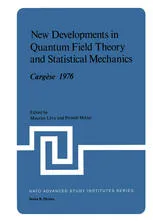New Developments in Quantum Field Theory and Statistical Mechanics Cargèse 1976
5.0
Reviews from our users

You Can Ask your questions from this book's AI after Login
Each download or ask from book AI costs 2 points. To earn more free points, please visit the Points Guide Page and complete some valuable actions.Introduction to "New Developments in Quantum Field Theory and Statistical Mechanics Cargèse 1976"
"New Developments in Quantum Field Theory and Statistical Mechanics Cargèse 1976" stands as a monumental compilation in the fields of theoretical physics and mathematics, capturing the revolutionary ideas and progress presented at the much-acclaimed 1976 Cargèse Summer Institute. Edited by distinguished scholars Maurice Lévy and Pronob Mitter, this book is anchored in diverse and profound contributions spanning quantum field theory, statistical mechanics, and every field that lies in their intersection. Through a series of lectures and papers, this seminal text elucidates the interplay between physics and mathematics, while revealing new pathways to tackle some of the most complex challenges of the era. With insights from luminaries like James Glimm and Arthur Jaffe, this book bridges gaps in understanding and opens doors for advanced research in a landscape rich with challenges and opportunities.
Detailed Summary
At the heart of this book lies an extensive and detailed effort to integrate the rapidly evolving developments of quantum field theory (QFT) and statistical mechanics (SM) as of the mid-1970s. These two disciplines, rooted in seemingly disparate paradigms, are tied together through striking parallels and shared mathematical foundations. The book highlights modern advances in functional integration, renormalization theory, and rigorous techniques in quantum field theory. It also delves into statistical mechanics’ formalism, particularly critical phenomena, lattice models, and phase transitions.
A major portion of the text is devoted to the rigorous application of mathematical tools to the formalisms of quantum field theory. Topics include the constructive approach to QFT, models in two and three dimensions, and the development of renormalization group techniques. In statistical mechanics, the book emphasizes the role of scaling laws, critical indices, and their connection to field-theoretic approaches. Key contributors articulate new results related to interacting systems, while offering methodologies to resolve challenges in proving fundamental theorems or deriving analytical approximations.
The complementary relationship between QFT and SM is masterfully illustrated through discussions of parallel theories—such as Euclidean fields mimicking statistical ensembles—and approaches to mitigating divergences in QFT through rigorous mathematical formulations. Discussions in this text provide both fresh perspectives and novel tools to scientists grappling with such topics at both foundational and applied levels.
Key Takeaways
- The indispensability of mathematical rigor in unifying quantum field theory and statistical mechanics.
- Clear exposition of renormalization methods and their applications across multiple disciplines.
- Breakthroughs in constructive approaches to QFT, offering tangible, computable solutions to deep physics problems.
- In-depth treatment of statistical mechanics' major problems, including phase transitions and the role of critical exponents.
- Illuminating the correspondence between Euclidean QFT and statistical mechanics, providing one of the first significant attempts to map the conceptual connections between the two subjects systematically.
Famous Quotes from the Book
"The crossroads of statistical mechanics and quantum field theory are a fertile ground for discovering the universal truths underpinning both physics and mathematics."
"Constructive field theory reminds us that the harmony of rigorous mathematics and physical intuition is not only desirable but essential."
"In renormalization, we find a bridge—not merely a method—connecting disordered microscopic chaos with the macroscopic world of coherent structures."
Why This Book Matters
This book is pivotal not just as a historical document that captures the essence of groundbreaking research in its era, but as a living testament to the evolving dialogue between physics and mathematics. The insights presented herein are still foundational to contemporary research in quantum field theory and statistical mechanics. Importantly, it provides the tools and methodologies for constructive approaches to theoretical challenges, making this volume equally indispensable to mathematicians and physicists alike.
Moreover, this book embodies the collaborative spirit of the Cargèse Summer School, reflecting the boundless potential of intellectual exchange among experts across different domains. As disciplines within theoretical physics grow increasingly interconnected, having this foundational material at hand provides modern researchers with both inspiration and a historical compass for navigating today’s challenges.
Whether you are a graduate student embarking on your journey in theoretical physics, or an experienced researcher in tune with the nuances of formalism, this book offers clarity, depth, and a wealth of ideas that transcend time. Its relevance only grows as the mathematical and physical sciences continue their perennial march towards understanding the universe at every scale.
Free Direct Download
Get Free Access to Download this and other Thousands of Books (Join Now)
For read this book you need PDF Reader Software like Foxit Reader


